
Spring certainly could not make up its mind this year in “weather” or not it really should make an appearance. Vacillating from overly warm temps in February and then plunging back down to snow filled and frost ridden days in March and a much cooler than average April, this has led to a much later gardening schedule. The dog days of summer feel like they have taken a grip with temps in the high 80’s today but I am sure that is not to last. Whatever Mother Nature has going on this year with her identity crisis, I can relate. Putting that aside, we have finally been able to spend a significant amount of time outdoors, specifically to make progress in the gardens… one of the aspects of this property that I fell in love with upon first glance…. and an aspect that takes more time than I ever imagined. It’s a good thing I love to garden!
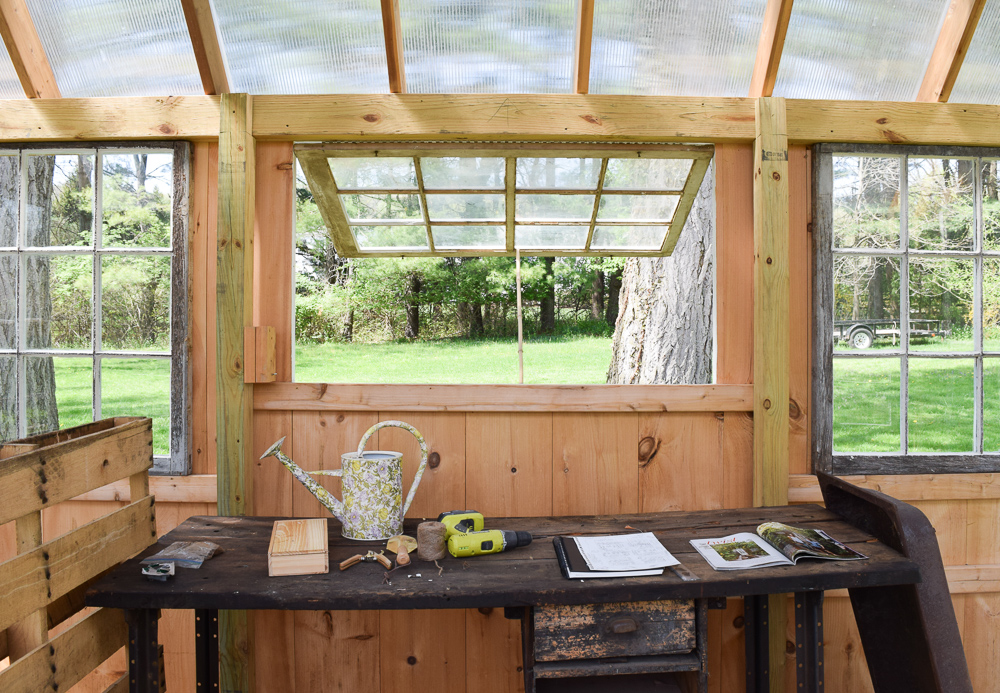
Now that the full clean up of the flower beds and paths have been completed, it is on to the vegetable garden which always gets last dibs. We are making a move to grow much more produce in our fenced in garden space for future plans that are in the works. Moving in that direction, since the deer here are a plentiful, we are going to grow up since we cannot grow out unless we redo all of the fencing. Not going to happen, so up it is! In order to do so, I am building, along with our son Christopher, a few structures that are super easy to do. In this post, I will show you a few of my favorites and then the biggie will be revealed in the next part of this series.
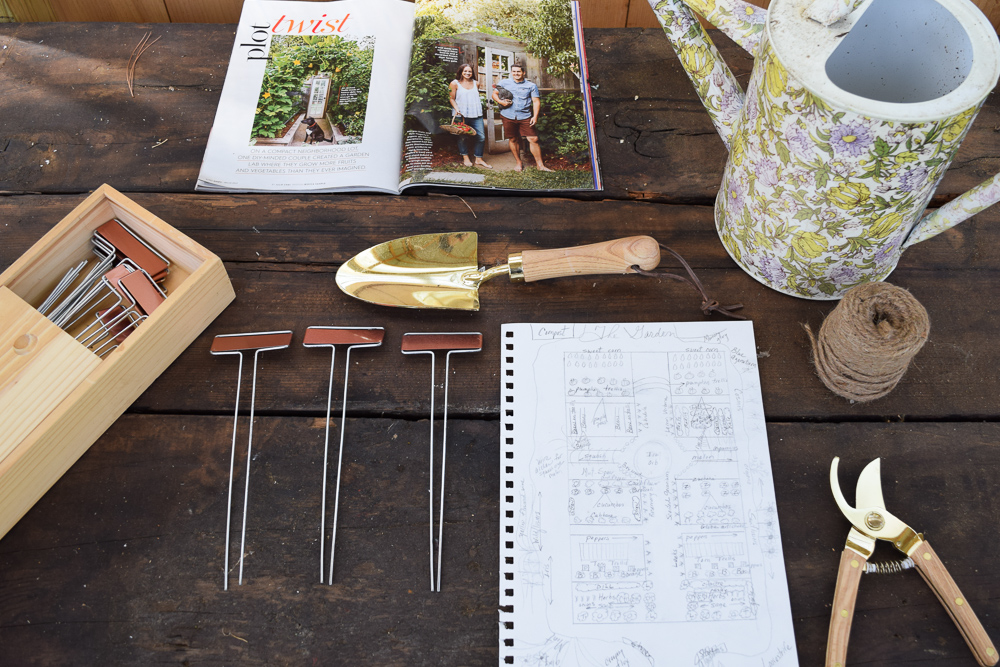
When planting, I always try to work off of of my master plan which I wrote about in Part 1 of the series.
You can read Part 1 here if you missed it.
I always make adjustments based on a variety of factors but one of the main ones is how well a plant does in the area I have switched it to this year. It is super important to rotate where you grow your crops each year. Don’t grow them in the same spot in your garden year after year for not only do they become less resistant to disease if you plant them in the same spot but each plant requires a particular set of nutrients that they use up.
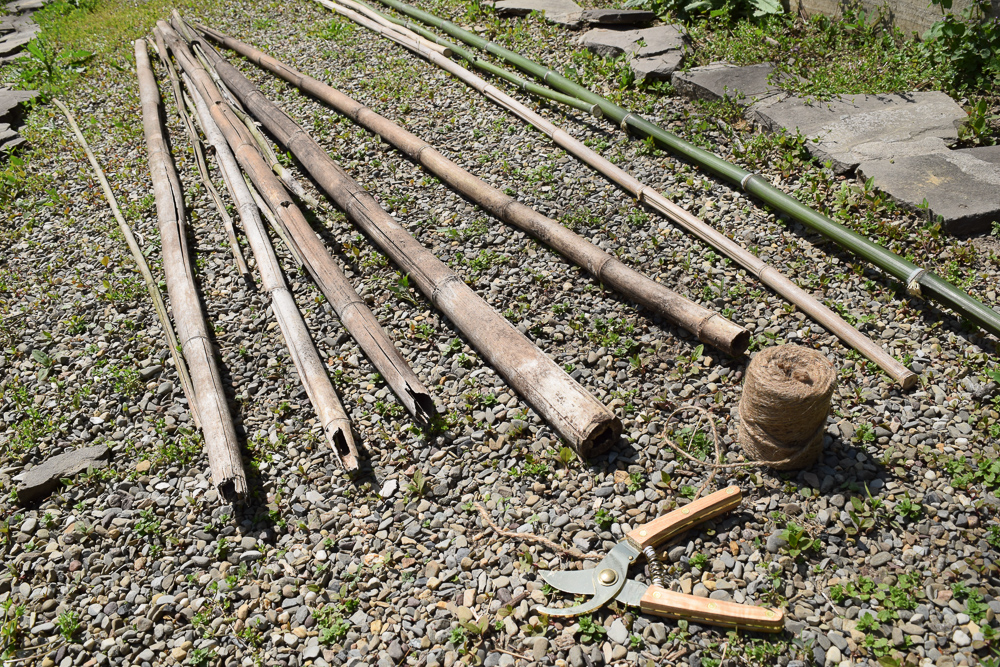
After I reevaluate the plans that I had drawn up inside earlier in the year and make any changes, I start assembling the materials that I will need to build the support structures that help the crops grow vertically instead of horizontally. We have many bamboo plantings here so this is one of my favorite materials to use for building teepee trellises and one of my favorite support systems to use in the garden. No tools required for this one, except for a pair of scissors or clippers to cut the string. If you don’t have bamboo, you can use sticks or long posts.
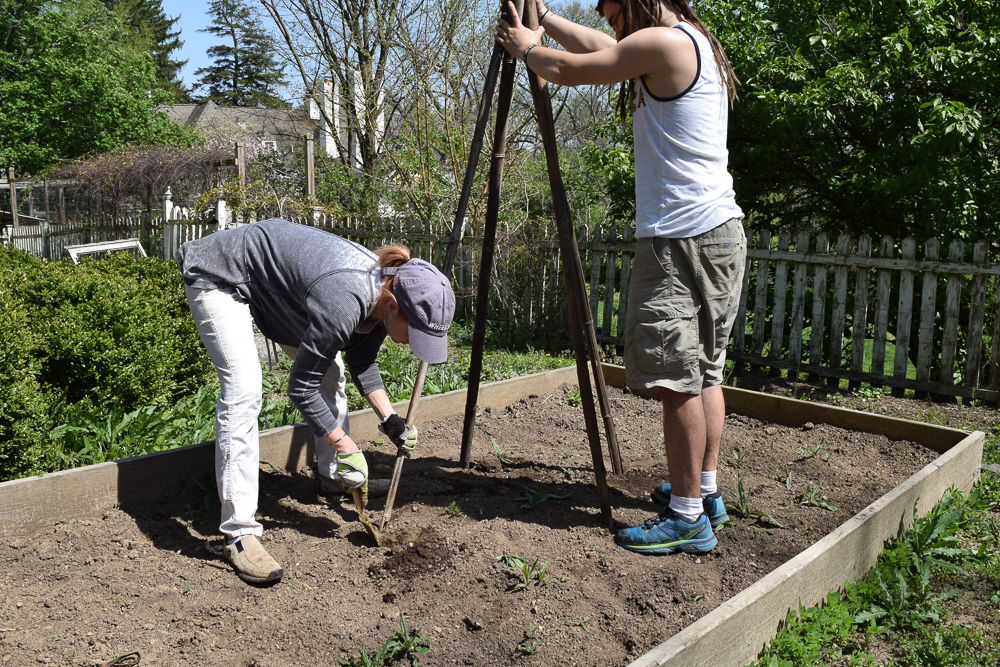
TEE-PEE Trellis
- Do not do this alone, for I have tried and its been an epic fail. There is no way to hold the posts in their proper position while securing them at the same time. Have a partner hold the posts up at the top after you form them into a tripod shape. You can use as many posts as you like as long as you have at least 3. I usually like to use 4. Dig a small hole at the base of each pole that the pole will sit in to help secure it. If you just sit it on top of the soil, it will be sure to blow down in the first wind.
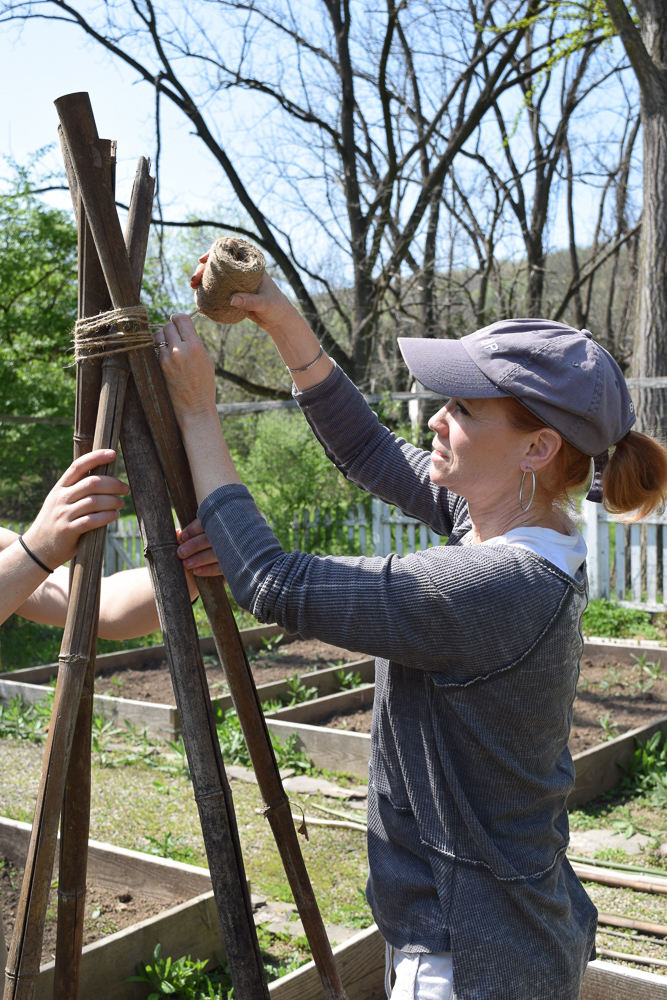 2. Once you have secured the bottoms of the posts into the soil and the tops fit into each other so that they stay up, wrap jute twine around them several times to keep them all together.
2. Once you have secured the bottoms of the posts into the soil and the tops fit into each other so that they stay up, wrap jute twine around them several times to keep them all together.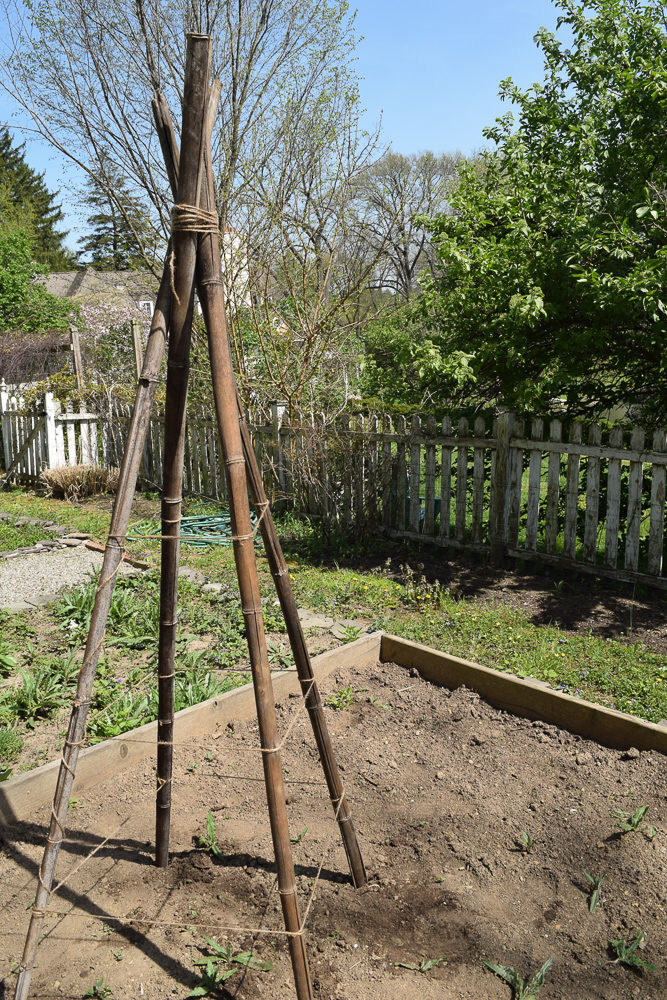 3. Once you have secured the top together with twine, tie an end of the twine around one of the posts at the bottom and knot it. Wrap it around the post once and then bring the twine to the next post to connect it, wrap it around and continue on to the third post and then to the fourth so that all are connected on the same level. Wrap the string up one of the posts so that you can do the same thing higher up your teepee and then again. You can do as many levels as you want for this not only keeps the trellis together but the string is what the tendrils of your climbing vine are going to attach to.
3. Once you have secured the top together with twine, tie an end of the twine around one of the posts at the bottom and knot it. Wrap it around the post once and then bring the twine to the next post to connect it, wrap it around and continue on to the third post and then to the fourth so that all are connected on the same level. Wrap the string up one of the posts so that you can do the same thing higher up your teepee and then again. You can do as many levels as you want for this not only keeps the trellis together but the string is what the tendrils of your climbing vine are going to attach to.
4. IGNORE the thistle in this garden! My husband and I already dug out all of it in the raised beds but there… is… no… getting… rid… of… this… nasty… stuff… permanently!
Sure, I could spray the heck out of it but I don’t use any chemicals so… we line all of the beds with black planting cloth to smother it and/or wet newspapers before we plant and mulch.That step is getting done after these structures are built. If any of you have a successful way to deal with it besides using chemicals or sprays, pleaseeeeee…. let me know! (WE do spray a mix of salt and vinegar on the tiny weeds in the stone beds and that works wonderfully in keeping them at bay, as well as the good ole fashion pulling method!)
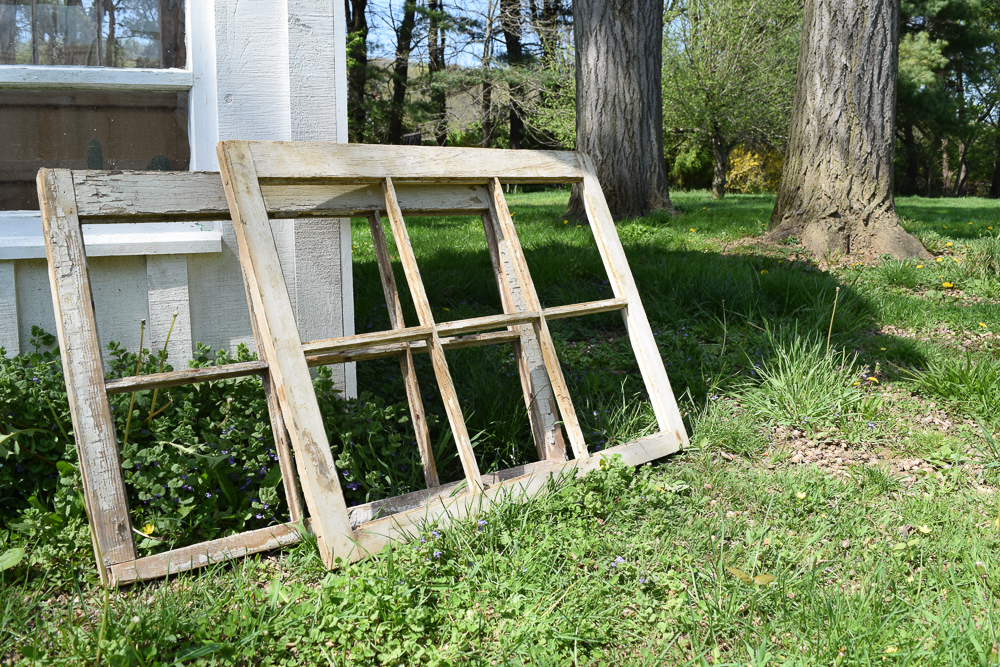
The next structure that I like to use for climbing crops utilizes old windows. I pick them up all over the place and they are quite simple to put together. The most difficult part of this project is finding two that are similar in size.
WINDOW TRELLIS
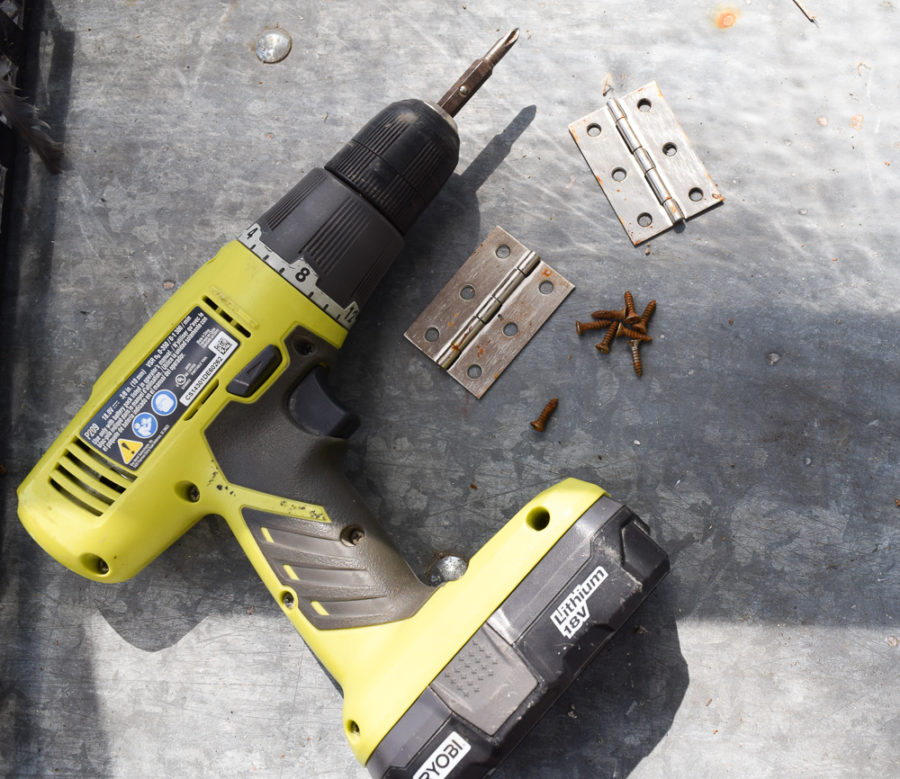
You will need a power drill, a pair of hinges with screws and two reclaimed windows.
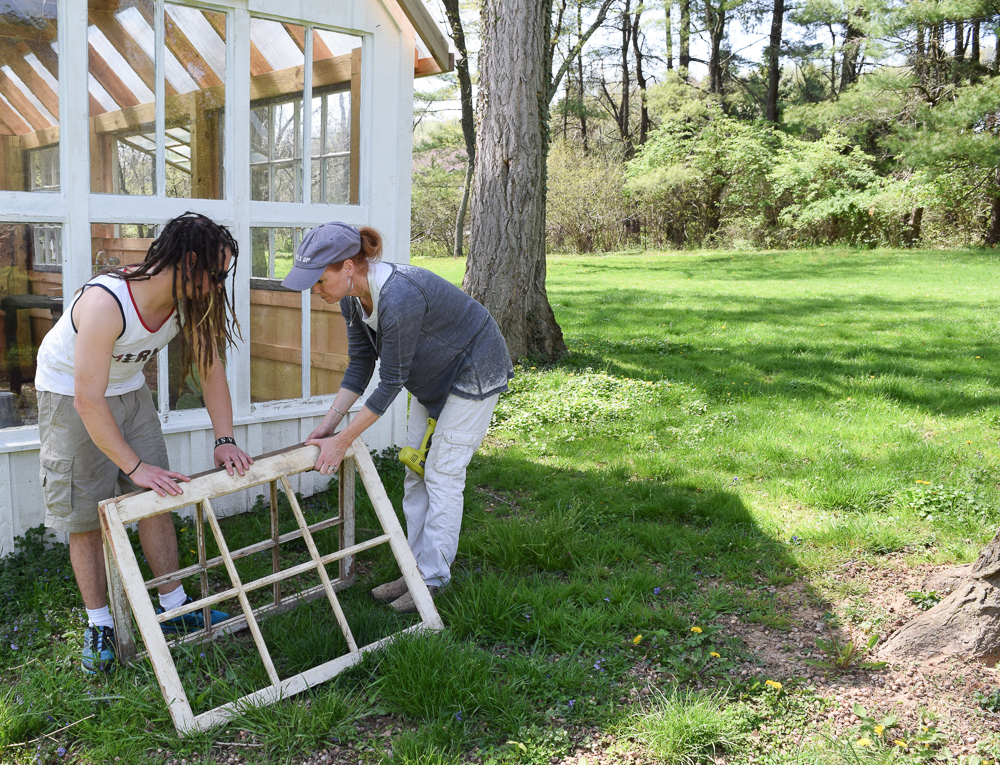
- Line up two similar windows in size either vertically or horizontally.
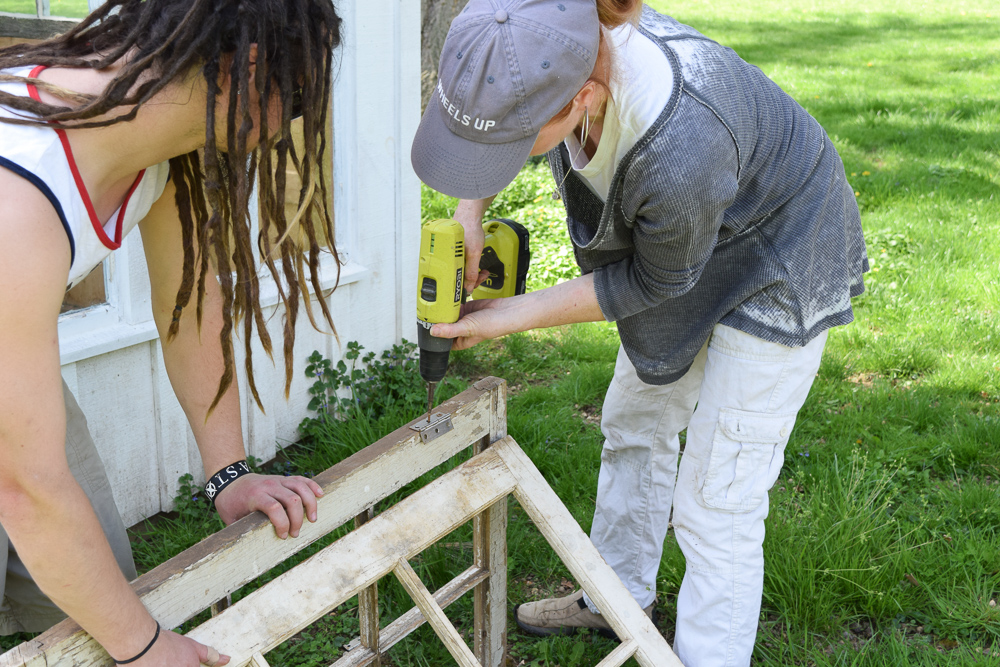 2. Use a power drill to screw in a hinge to the top of one of the windows on one end. Screw in a hinge on the other end of the same window as well.
2. Use a power drill to screw in a hinge to the top of one of the windows on one end. Screw in a hinge on the other end of the same window as well.
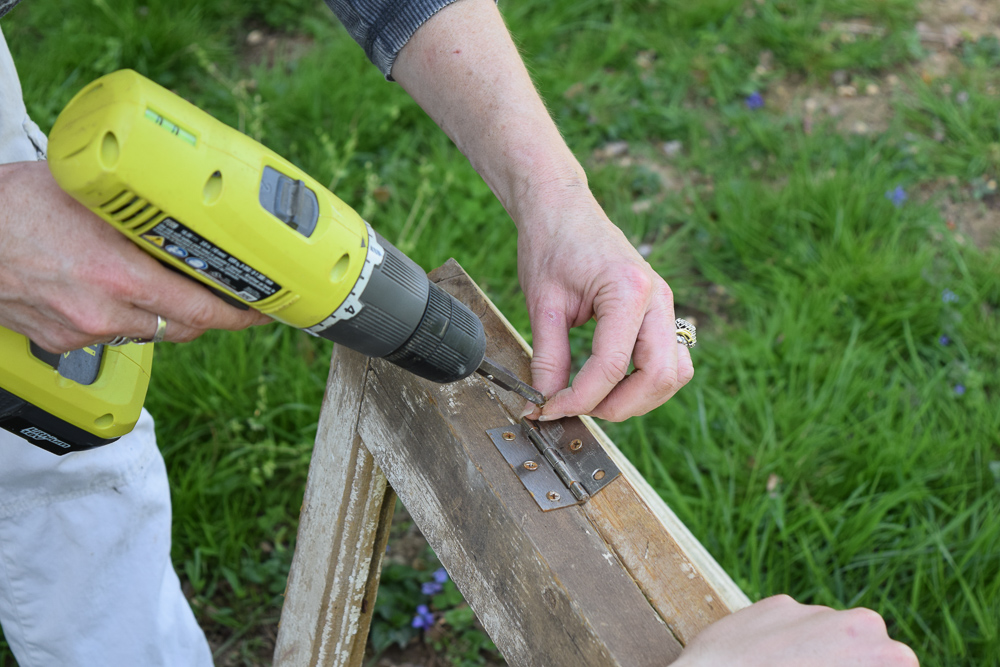
3. Line up the second window in front of the first at an angle and screw in the connecting side of the hinge. You can use L brackets on the inside of the window to create a permanent angle but I like to use the hinges so the windows can fold flat to move or store them.
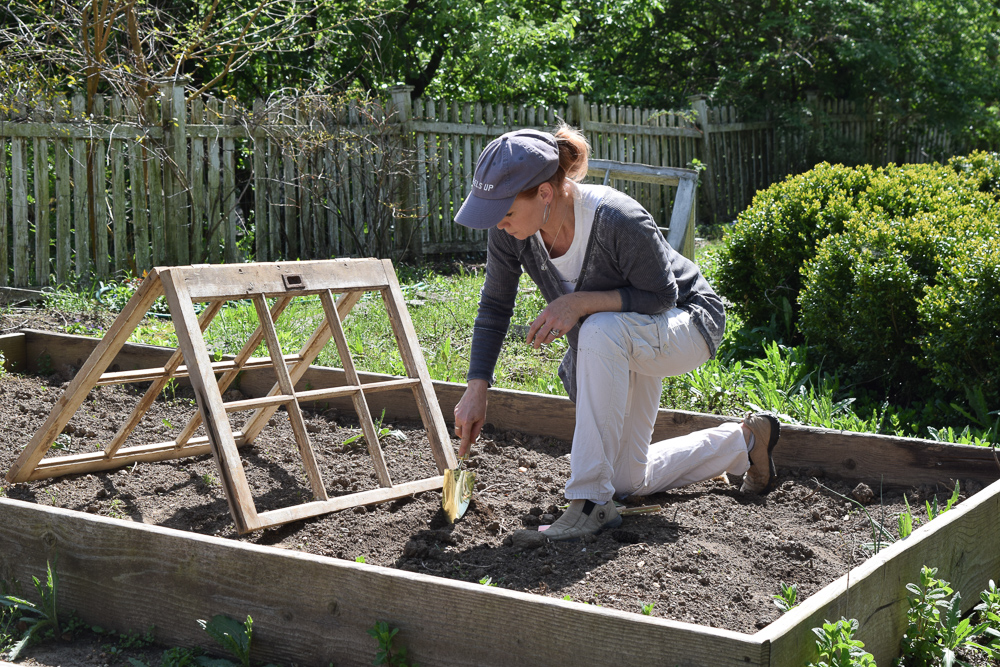 4. Set up the window in an A-frame shape and then plant your seeds or plants right at the edge of them so that they use the window panes to grow up. You usually have to train the vines to grow up the trellis and then over the other side. Sometimes I add a thin string across the window panes to help the plants climb up as well. I like to plant cool crops, like lettuce underneath the trellis.
4. Set up the window in an A-frame shape and then plant your seeds or plants right at the edge of them so that they use the window panes to grow up. You usually have to train the vines to grow up the trellis and then over the other side. Sometimes I add a thin string across the window panes to help the plants climb up as well. I like to plant cool crops, like lettuce underneath the trellis.
 There is another structure that I am going to be working on next week that utilizes the pallets that we get from our shipments. As I have stated before, I have a very hard time throwing anything out and I have many stacks of these behind the barn. This year, I will be using a few to form some archways and very large trellis systems. On a side note, we have a duck nest with 10 or 11 eggs in it sitting underneath a lean to we made out of pallets for the goats on the island. We will take photos as the mama gets used to us so she does not abandon the nest.
There is another structure that I am going to be working on next week that utilizes the pallets that we get from our shipments. As I have stated before, I have a very hard time throwing anything out and I have many stacks of these behind the barn. This year, I will be using a few to form some archways and very large trellis systems. On a side note, we have a duck nest with 10 or 11 eggs in it sitting underneath a lean to we made out of pallets for the goats on the island. We will take photos as the mama gets used to us so she does not abandon the nest.
A few other tips that I would like to share with you besides building structures and how easy they really are to construct are below:
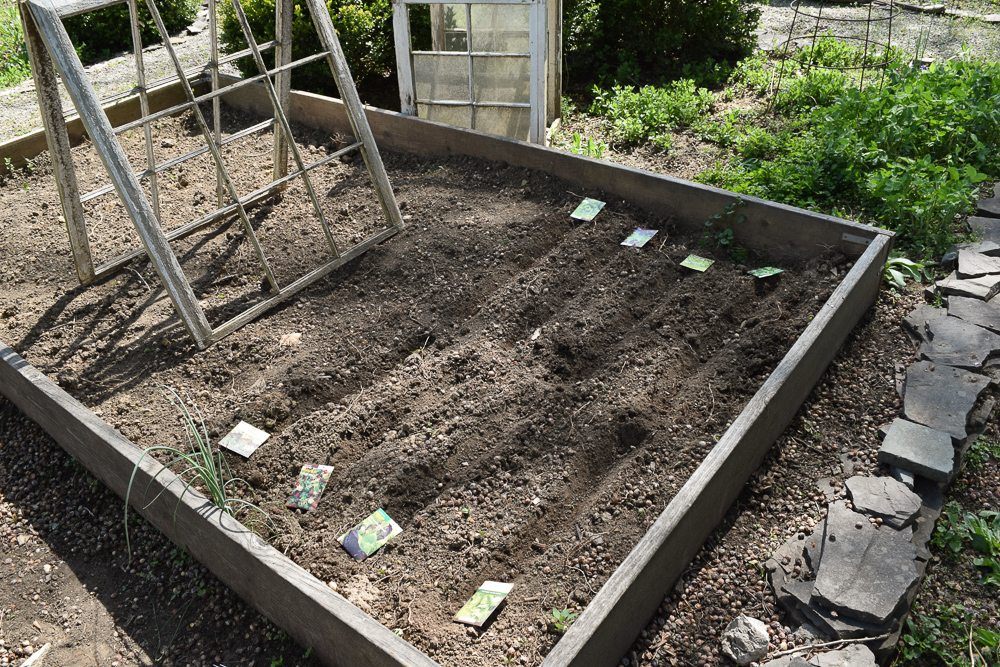
- When planting from seed directly into the bed, I always mark the rows with the packets but I then use a permanent marking system so I know what is supposed to come up and where!
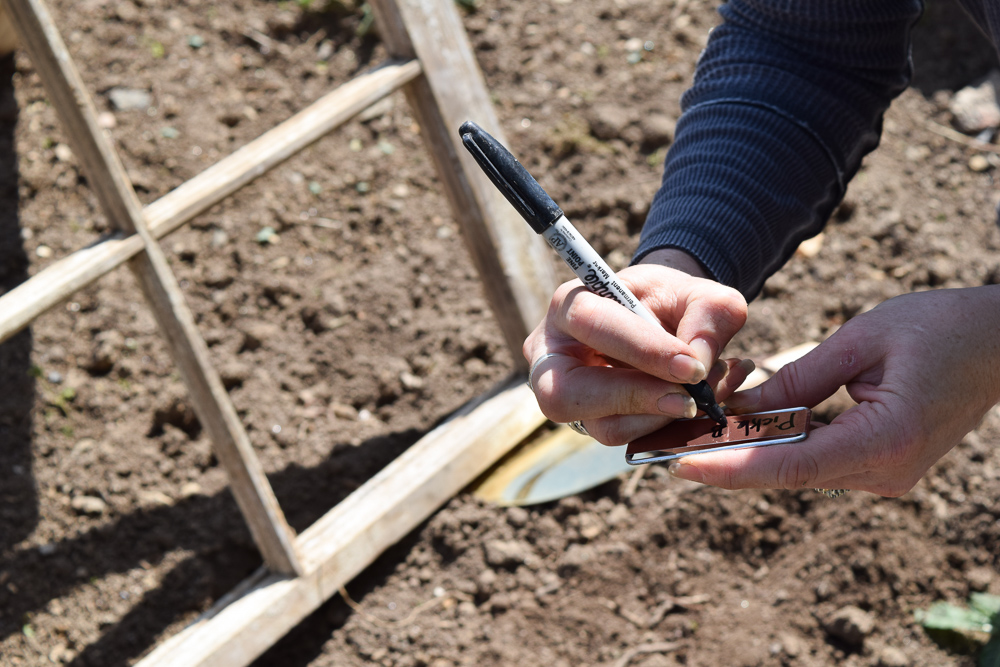
One of my favorite tools to use are these copper banded plant markers. I found packets of 6 in the Dollar section at Target this year. Use a sharpie marker to label the seeds you just planted and place in front of the rows of seeds.
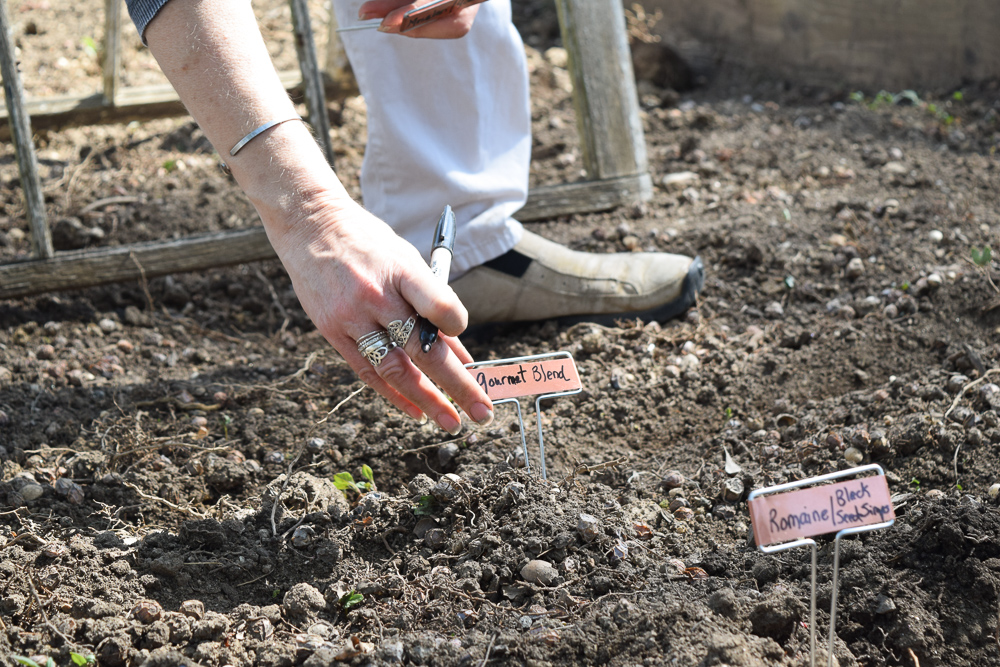
Compost… compost… compost! I have a large compost area in the back of the garden where we dump egg shells, vegetable and fruit scraps that cannot go to the animals, tea bags and coffee grinds! Did you know that some Starbucks set out their bags of coffee grinds for you to take for FREE? Ask at your local coffee shop!
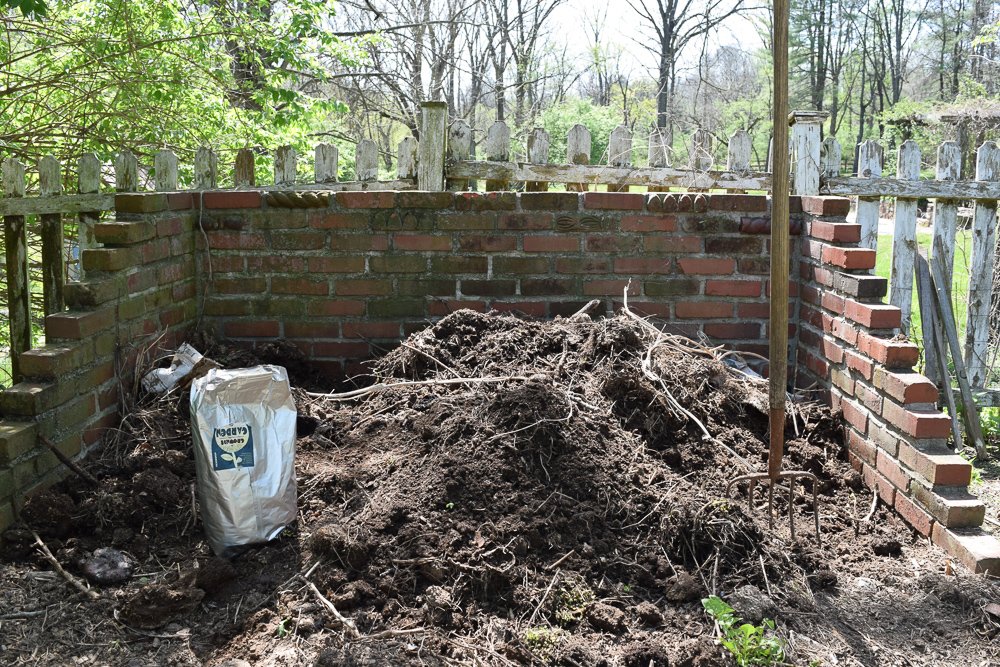
If planting from seedlings, I always place them in the spots where they are to be planted first so as to get spacing issues figured out before you start digging. I try to use companion planting where you place plants next to plants who like to be next to each other… kind of like friends. There are lists of beneficial plantings on many gardening websites. I will write more about that as I plant all of our seedlings which will happen in the next two weeks.
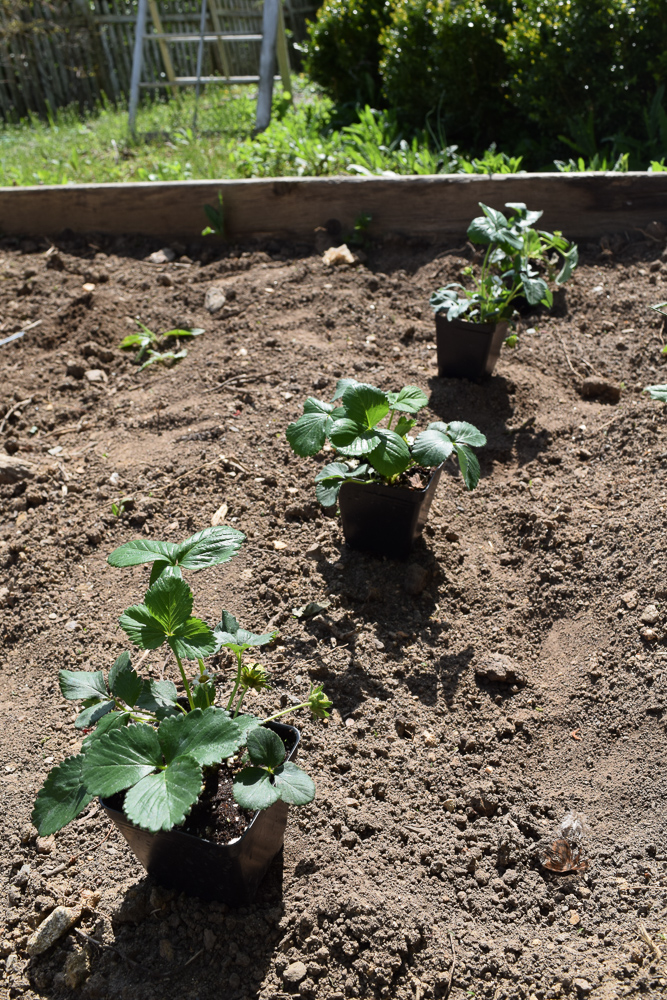
As I mentioned earlier in this post… we are way behind the eight ball this year in when we plant due to the earlier cold. Most of our trees are just beginning to leaf out right now.
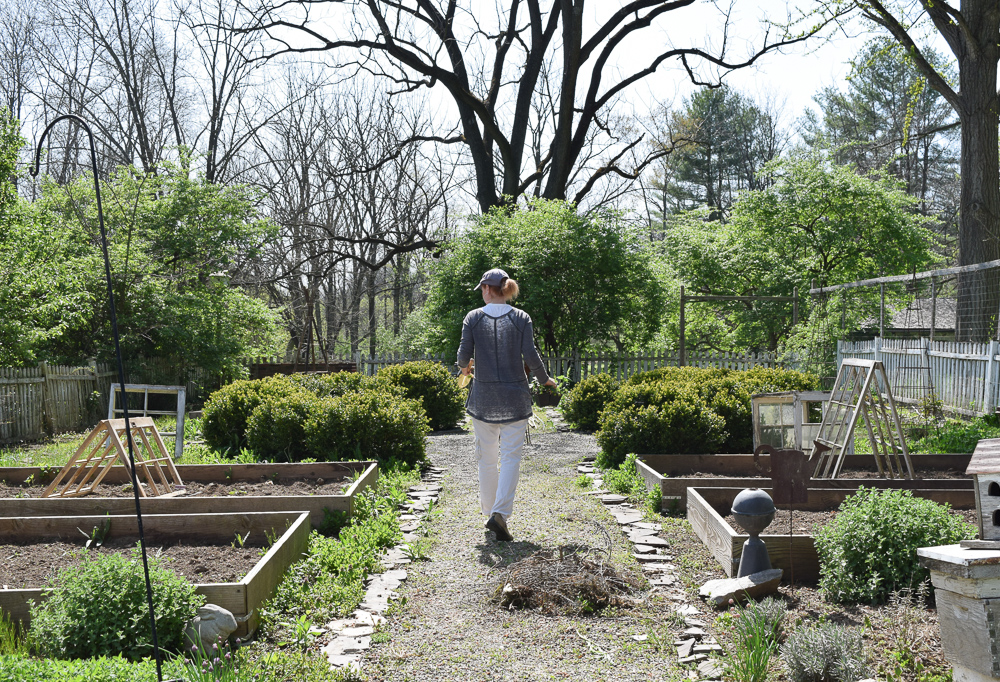
This truly is my favorite time of year… behind Christmas! My days and late evenings spent in the garden are some of my favorites. With gardening there are measurable results from your hard work. In can be daunting for you are dealing with live things who have a will of their own. With much rain, you get many weeds but much growth. With heat and dryness, you have to supplement the garden and give it more TLC so as to keep it well watered. It is constant, it is hot, dirty work but oh so rewarding as the season progresses!
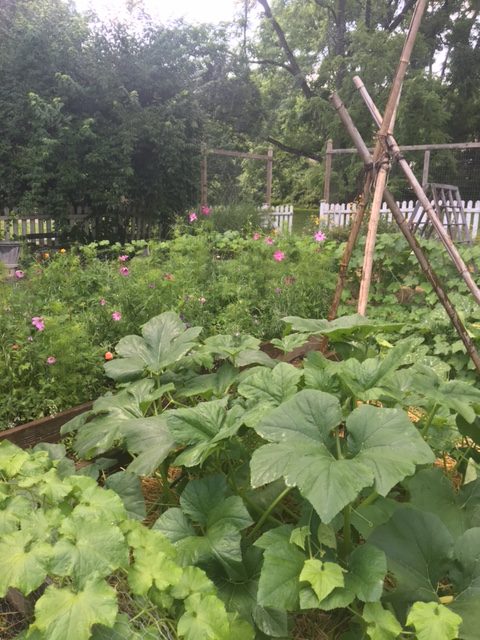
Flashback to late in the season last year after the peas and beans had come dow off the trellises.
Come along with me on the journey this year as we post every couple of weeks to show you the progress and learn how to build some of the other structures we are going to implement in this space. Would love to see some of your spaces as well that are filled with the fruitful labors of your gardening passion!
xoxo
~Meg
“The glory of gardening: hands in the dirt, head in the sun, heart with nature. To nurture a garden is to feed not just the body, but the soul.”
Alfred Austin
Great post-love your garden. are the extra tall “sticks” over the picket fence to keep the deer from jumping in?Is it enough? We did a similar thing with vertical sticks and then clothesline from stick to stick….but concerned the clothesline won’t be enough deterrent. Last year was ok but we have more deer now due to new construction nearby. One stands about 30’from the garden and snorts at me as if to say, that’s MINE.
Hi Paula,
Those tall sticks, sticking up from the picket fence is another fence! We call it “Deer-cra-traz”! We connected wire between the tall fence posts and ran it about 8 feet high and they have not jumped it. They are pretty brazen! I have heard you can hang plastic bags from your fences and they don’t love that but neither do we… for it’s not too pretty!
Happy gardening Paula and thanks for sharing the love of our garden!
Meg
Meg,
I really appreciate this view into how you plan your garden. Please include me with The Flower Project when it is up and running! What a lovely idea.
My husband and 12 year old daughter start seeds inside every Spring around March. I live with starter plants balanced on mason jars up under the fluorescent lights under the cabinets in my kitchen (easy to remember to water with the sink an arms length away) and on the Living room window seat in front of our big bay window which gets the most sun and even balanced on top of wine making equipment which itself is on a large table way up high under the fluorescent lights in our basement. It is only for a month or two, but when you see the fruits of the their labors…basil plants on their way to pesto pasta dinners, parsley ready to be pinched for tabouli lunches, and fragrant flowers for simple arrangements for the garden side dinner table…its all worth it.
Keep the beautifully photographed and inspirational garden posts coming.
Dear Barbara Ann,
Thank you so much for commenting! I LOVE your story that you shared of how you start your seeds! It is a family affair which is the best way. You are soooo right about keeping things close to the sink so you don’t forget to water them… always an issue I have! Seeing the fruits of your labor is the ultimate reward and is what keeps me planting, just as it does you.
I will have another installation coming up soon and stay tuned and happy planting!
All my best~
Meg